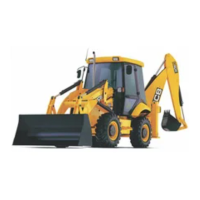3 - 2
Safety Procedures
The air conditioning system uses refrigerant under pressure
in a closed circuit. Any service procedure which breaks into
the closed circuit and therefore requires discharging of the
system, must only be carried out by an air conditioning
engineer. The following guidelines should be adhered to by
all personnel servicing the air conditioning system.
!!
WARNING
The air conditioning system is a closed loop system and
contains pressurised refrigerant. No part of the system
must be disconnected except by a qualified refrigeration
engineer.
4-3-4-1
1 It is critical that the correct refrigerant is used and that
charging is done only by qualified personnel. It is illegal
to discharge the refrigerant into the atmosphere but as
a precaution in case of accidental leakage, discharging
and charging of the vehicle refrigerant system must be
conducted in a well ventilated area.
2 Containers of refrigerant should be stored in a cool
environment away from direct sunlight.
!!
WARNING
Do not carry out welding operations close to the air
conditioning refrigerant circuit. A poisonous gas is
produced when refrigerant comes into contact with
naked flames. Do not smoke or allow naked flames close
to the refrigerant circuit.
BF 1- 9
3Do Notperform welding operations close to refrigerant
hoses (maintain a distance of at least 0.5m from hoses).
4Do Notsteam clean refrigerant system components.
5 When charging or discharging the refrigerant system,
no smoking or naked flames should be allowed in the
immediate vicinity. The refrigerant does not give off a
poisonous odour, however, when it comes into contact
with a naked flame, a poisonous gas is produced.
6 When handling refrigerant, rubber gloves and goggles
should be worn. Operators should ensure no refrigerant
comes into contact with the skin. Particular care should
be taken when connecting or disconnecting charging
hoses or pressure switches. When these components
are connected to the system, a short release of
refrigerant occurs. This results in a high velocity, very
cold gas being emitted from the connection point.
7 When checking the state of the refrigerant at the
receiver drier sight glass, it is necessary to run the
engine with the LH side panel removed and the bonnet
raised. Extreme care must be taken to avoid moving
engine parts such as fans, pulleys and belts.
Section B Body & Framework
9803/7130
Section B
3 - 2
Issue 1
Basic Operation
Air Conditioning (cont'd)
The high temperature, high pressure refrigerant is forced by
compressor action into the expansion valve D, which meters
the amount of refrigerant entering the evaporator. In the
expansion valve the refrigerant instantaneously expands to
become a low pressure, low temperature liquid.
The refrigerant is drawn through the evaporator coil E by the
suction of the compressor. The temperature of refrigerant is
now considerably below that of the air being drawn across
the evaporator coil by the blower. Heat is transferred from
the ambient and recirculated air to the refrigerant, causing
the low pressure liquid to vaporise and become a low
pressure gas. Moisture in the air condenses on the
evaporator coil and is drained away via condensate drain
tubes through the cab floor.
Cool de-humidified air is emitted through air vents into the
cab.
The low temperature, low pressure, high heat content
refrigerant gas, is now drawn by suction back to the
compressor, where the cycle is completed.
System Control
Control of the system is achieved by the cyclic action of the
compressor's electromagnetic clutch. The thermostat switch
senses the evaporator coil temperature by means of a
capillary tube and cycles the compressor clutch on and off
to prevent freezing of condensate on the evaporator coil.
The signal from the thermostat switch is sent to the
compressor clutch via two pressure switches. These are
designed to disengage the compressor clutch and protect
the system from damage that would be caused by either
refrigerant loss or excessive pressure.
The low pressure switch H is connected to the suction hose
adjacent to the compressor. If the pressure in the suction
hose falls below the low pressure switch setting, it opens,
interrupting the supply from the thermostat to disengage the
compressor clutch.
The high pressure switch J is connected to the discharge
hose adjacent to the compressor. If the pressure in the
discharge hose rises above the high pressure switch setting,
it opens, interrupting the supply from the thermostat to
disengage the compressor clutch.
Switch Pressures
Low Pressure Switch
Cut in = 2.1-2.6 bar (30-38 lbf/ in
2
)
Cut out = 0.3-0.6 bar (4-8 lbf/ in
2
)
High Pressure Switch
Cut in = 15.5-19 bar (225-275 lbf/ in
2
)
Cut out = 23.4-24.8 bar (340-360 lbf/ in
2
)

